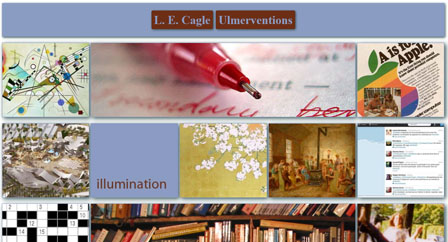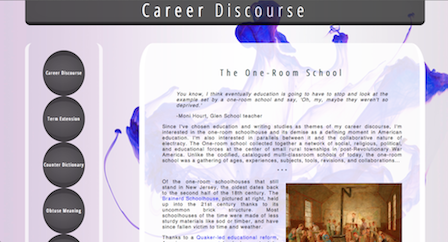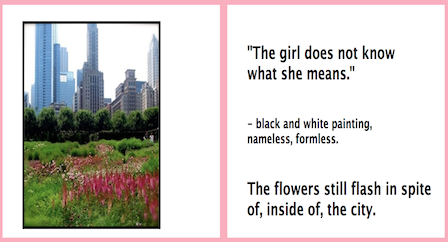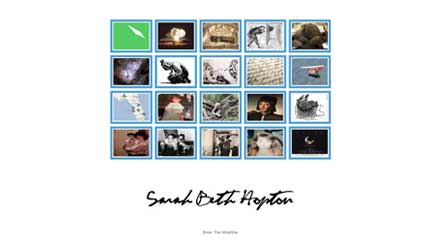Our [Electrate] Stories
Explicating Ulmer's Mystory Genre
Marc C. Santos, Ella R. Bieze, Lauren E. Cagle, Jason C., Zachary P. Dixon, Kristen N. Gay, Sarah Beth Hopton, Megan M. McIntyre
Electracy
“The wide image [mystory] is the magic tool that allows the egents to confront the problem, the obstacle, the trouble of their world" (Ulmer, 2003, p. 183).
Gregory L. Ulmer (2003) reconceptualized not only the methods but also the aims of composition in light of digital affordances. His focus is not about transposing words or ideas, sentences, paragraphs, or arguments into code; it is not about transporting rhetoric and composition online. Nor is it simply recognizing how new technologies usher in new forms of expression. While electracy adds images and sounds to our communicative repertoire, its most significant impact concerns how these new forms of expression help reconceptualize the human otherwise than as the Cartesian, individuated self central to literacy's logocentric forms of thinking/doubting/reasoning.[4] In Ulmer’s electrate institution, rhetoric and composition would augment its traditional (literary) emphasis on logic and reason with a sophisticated appreciation for feeling and affect. Ulmer’s mystory genre, the core assignment of Internet Invention, takes steps to realize these technological, institutional, and subjective transformations.
Ulmer (2012) explicitly identified these three domains—technology, institution, and selfhood—as core components of any communicative epoch. Taking the web as an evolution in communicative technology, his project worked to redefine the latter two terms: institution and selfhood. In terms of institution, he offered the EmerAgency, his neologism for the kind of affectively sensitive digital consulting lacking from contemporary politics and civic decision-making. If we agree with Ulmer’s (2012) supposition that the primary institution of orality (the church) and literacy (the state) has been supplanted by the entertainment industry, then we can clearly recognize the necessity for education to take more seriously the role entertainment plays both in the formation of the self and in political decision-making (p. 49). Thus, the mystory is Ulmer’s response to the contemporary crisis of agency, ushered in by the rush of technology and the philosophical deconstruction of the autonomous, rational, Cartesian subject and the rise of Modern political alienation.[5] By “Modern political alienation” we refer to the work of Bruno Latour. Unfortunately, we do not have space here to offer a complete explication of Latour’s works, but would stress that Latour (1993; 1996; 2004) explicated how Modern epistemology institutes unproductive rifts between scientists, humanists, politicians, and the general public. Latour attempted to reconnect these disparate groups. We believe that Ulmer’s mystory takes steps to realize Latour’s ambition by stressing interdisciplinary exploration and demonstrating a new, unique form of digital agency. Like Latour, Ulmer framed agency as a matter of networked participation rather than individual autonomy.[6]
In terms of selfhood, Ulmer offered avatar, a term borrowed from video gaming, as a replacement for the literate concept of subjectivity and the oral concept of the spirit.[7] An avatar’s agency is contingent upon its place within a network: like a player in a game, it is neither powerless nor autonomous. An avatar is always at work within a larger system yet retains the ability to change that system.
Critics of the mystory genre might point out how it fails to take advantage of one of the web’s key affordances: it is not dialogic, participatory, or communal. In fact, Ulmer (1989) proposed that the “best response to reading a mystory would be a desire to compose another one, for myself” (p. vii). Though published on the Internet, the mystory is mostly an individualistic, isolated exercise (even if the point of the exercise is to reveal our dependence upon others—a point we will emphasize at the conclusion of this section). Such a statement flies in the face of not only the wiki/hacker culture we associate with the Web (Holmevik, 2012), but also the dominant theories of dialectical critical engagement underwriting the last 25 years of composition pedagogy. Since James Berlin (1988), rhetoric and composition has been conditioned to raise a skeptical eye to expressivist pedagogies. Given its emphasis on exploring the individual, and its interest in affect and emotion, the mystory celebrates some of the core elements of expressivism that Berlin vilified. By analyzing the mystory from the perspectives of Berlin’s expressivist and socio-epistemic lenses, we can identify how radical, yet effective, Ulmer’s articulation of electracy might be. We recognize that it might seem strange to analyze Ulmer’s work from a critical ontology developed by Berlin in the late 1980’s. We read Ulmer through Berlin’s rhetorical categories in order to suggest the extent to which Ulmer’s electrate postpedagogy extends, transforms, and challenges some of our most established notions of agency and pedagogy.
Berlin, Ulmer, and the Possibility of Socio-Expressivism
Berlin (1988) offered his most damning rejection of expressivist pedagogies in his canonical essay, “Rhetoric and Ideology in the Writing Classroom,” where he indicated expressivism with two particular charges. First, because it identified the social as a corrupting force that tarnished the authenticity of the individual, collective action became more difficult:
[ ... ] expressionistic rhetoric is inherently and debilitatingly divisive of political protest, suggesting that effective resistance can only be offered by individuals, each acting alone. Given the isolation and incoherence of such protest, gestures genuinely threatening to the establishment are difficult to accomplish. (Berlin, 1988, p. 487)
Hence, expressivism offers no explicit political project, but rather a “subversiveness [ ... ] more apparent than real” (487). As already noted, Ulmer maintained the ideal response to a mystory is the composition of another mystory; thus, it can be difficult to see how one would translate the insight of the mystory (or an electronic monument) into direct, impactful political action. However, this assumes that the immediate purpose of the mystory is such action. While the mystory is not the kind of direct political action sought by Berlin, it is an important step in cultivating an agent (or, as Ulmer identifies them, an egent) capable of acting politically and ethically in the 21st century. We will return to this point in the conclusion of this section.
While the mystory is an individualistic genre, one would not say that Ulmer’s theory of avatar reflected Berlin’s characterization of the romantic expressionist subject:
This [expressionist] rhetoric has usually been closely allied with theories of psychology that argued for the inherent goodness of the individual, a goodness distorted by excessive contact with others in groups and institutions. In this it is the descendent of Rousseau on the one hand and of the romantic recoil from the urban horrors created by the nineteenth-century capitalism on the other. Left to our own devices, this position maintains, each of us would grow and mature in harmony. Unfortunately, hardly anyone is allowed this uninhibited development, and so the fallen state of society is both the cause and effect of its own distortion, as well as the corrupter of its individual members. (Berlin, 1988, p. 484)
For Ulmer, there is no sense of a self apart from others. There is no self uninhibited from the influence of networks. We jestingly refer to Ulmer’s postpedagogy as a socio-expressivism: the mystory is an attempt to map the recursive, feedback-infused influence of networks, to reveal what / who bounds a self into the avatar that plays me / that I play. Ulmer’s avatar frames selfhood as a messy conglomeration of body and mind engendered and sustained through networks. A central goal of the mystory concerns exposing this conglomeration via memory. Ulmer drew upon Roland Barthes' (1981) concepts of studium and punctum, describing the mystory’s use of photographs to trigger what Barthes described as the sting of personal memory, the ways it idiosyncratically divests itself from “the public encyclopedia of concepts” (Ulmer, 2003, p. 44). Thus, unlike the forms of expressionism Berlin condemned, Ulmer’s mystory remains mindful of the material and the ways the material engenders selfhood.[8] The mystory genre aims for more than a digital renewal of the ancient Socratic mantra of “know thyself.” The mystory, by rejuvenating our faith in personal testimony, attempts to fashion a digital form of agency that returns politics back to the individual.
Second, Berlin (1988) condemned expressivism on the grounds that it “is open to appropriation by the very forces it opposes in contradiction to its best intentions” (p. 478). Berlin (1988) contrasted this risk against his socio-epistemic rhetoric, which attempted to assure a self-reflexiveness that “provides itself a defense against preemption and a strategy for self-criticism and self-correction” (p. 478). In her reflection, Sarah Beth Hopton noted a concern that the mystory’s attempt to co-opt corporate expressions (such as the logo, see Internet Invention’s Wide Emblem exercise; Ulmer, 2003, pp. 246-247) might actually reinforce the very cultural expressions Ulmer seeks to call into question. From Berlin’s (1988) perspective of socio-epistemic rhetoric, the exploration of media and entertainment at the heart of the mystory project offered no guarantee of an “explicit critique of economic, political, and social arrangements” (p. 490), Berlin’s central concern. As with expressionistic rhetoric, the possibility of such critique remained at best “implicit” (Berlin, 1988, p. 490).
In short, Ulmer’s mystory, like expressionistic rhetoric, makes no explicit move to demystify a student’s false consciousness (Berlin, 1988, p. 490). Again, it looks to “sting” them emotionally, in the sense of Barthes’ (1981) punctum (see Ulmer, 2003, p. 44). Jeff Rice (2007) characterized this sting as a kind of aha moment, one that awakens the student to see unexpected relationships and ask unanticipated questions. Thomas Rickert (2007) referred to this kind of moment as surprising, stressing that it is a kairotic emergence for which we necessarily cannot plan and which we certainly cannot guarantee (pp. 172-173). The surprising aha moment is not a function of pedagogical mastery but of pedagogical serendipity.[9]
Given Ulmer’s investments in poststructuralist, particularly Derridean, theory, we should not be surprised to find such an endorsement of (pedagogical) risk. Jacques Derrida (1988) marked iterability as the contextual contingency of the signature haunting (written) communication; the authentic presence of the signature/subject comes only with the risk of its forgery. For Derrida (1988), the risk of failure was essential to possibility, to being itself (pp. 100-01). Rather than seeking to minimize or even eliminate risk, treating it as an external threat to the integrity of a system/being, Derrida (1988) framed it as an “internal and positive condition of possibility” (p. 103). Ulmer’s mystory radicalized this appreciation for risk; the mystory realized the ambitions of his first major work, Applied Grammatology (1985), which distilled from Derrida’s grammatology “a pedagogy that would collapse the distinctions separating teaching, research, and art [and thus] might have also the power to guide transformations of the lived, social world” (p. 27). Applied Grammatology anticipated Berlin’s critique that such a risky, deconstructive pedagogy cannot ensure cultural transformation: “the entry point of his [Derrida’s] deconstruction [...] is the (clandestine, but nonetheless ‘violent’) introduction of heterogenous forces into the ‘teaching body’ in order to deform and transform it, taking the risk that such forces might be reappropriated or be unreceivable” (Ulmer, 1985, p. 160). The confusion that surrounds Internet Invention’s assignments, the book’s idiosyncratic style, its proliferation of neologisms, the way in which the book challenges our assumptions regarding the genre of the textbook, all disrupt the expectations of teaching which Paulo Freire (2000) so famously analogized as banking. Ulmer’s postpedagogy fundamentally rejects the mantra that individuals can be taught and instead favors celebrating the possibility that they can learn (Santos & Leahy, in press). Of course, this prohibition on teaching includes any claim toward teaching progressive politics or ideological critique.
In dialectic’s insistence upon overt political exchange, Berlin proposed it too easily risks eliminating this radical, Derridean risk in favor of indoctrinating the True politick. Postpedagogical theorists such as Sarah J. Arroyo (2005), Rickert (2007), and Karen Kopelson (2003) argued for subversive—or as Kopelson identified them, “cunning”—approaches to critical pedagogy that do not explicitly confront students’ ideological investments, but rather open spaces in which students can generate their own questions and confrontations. Rickert (2007) noted how critical pedagogues operating in the tradition of Berlin’s socio-epistemic pedagogy such as John Schilb (1996) and Mas’ud Zavarzadeh (1992) critiqued Ulmer in the spirit of Berlin’s objections to expressivism. They stressed how his postpedagogical approach fails to appreciate the extent to which ideology permeates cultural experience and precludes an “overt political presence in the classroom” (Rickert, 2007, p. 116). However, Rickert (2007) argued that the criticisms critical pedagogues “levy at Ulmer actually function as praise, demonstrating the extent to which Ulmer has achieved a real advance” (p. 116). Ulmer's postpedagogical approach leverages personal experience against the social and material discourses in order to address the problems targeted by Berlin: how can teaching best improve the lives of our students and the problems of our society? By helping students to ask ideological questions and providing them a space to work out and share their answers.
Our hope is to suggest how the mystory might contribute to a socio-epistemic inspired project, one progressive in its politics, by cultivating an avatar with an ethical disposition commensurate to participating in agonistic, political struggle. Julia Kristeva (1991) reminded us: “To worry or to smile, such is the choice when we are assailed by the strange; our decision depends on how familiar we are with our own ghosts” (p. 191). Ulmer’s proposed avatar atunes herself to her own ghosts, thus practicing listening, in the self-effacing, empathic, loving, rhetorical manner advocated for by Diane Davis (2010), Jean-Luc Nancy (2007), Krista Ratcliffe (2006), Cheryl Glenn (2004), Kelly Oliver (2001), Jim W. Corder (1985), and others. A number of students in the class recognized affinities between Ulmer’s postpedagogical approach and feminist posthumanist notions that we are always already alien, always already touched by technology (Price Herndl, 2002; Haraway, 1991). By helping an avatar discover what supports it (Santos, 2011), Ulmer’s mystory contributes to a public sphere that is more empathic, more patient, and more possibly suited to enacting change. Hence why, while the mystory might not demand the explicit kind of political demystification insisted upon by Berlin, it might better advocate the kind of progressive politics such a demand hopes to inspire.





